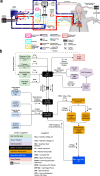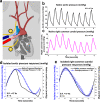Maintenance of pig brain function under extracorporeal pulsatile circulatory control (EPCC)
- PMID: 37626089
- PMCID: PMC10457326
- DOI: 10.1038/s41598-023-39344-7
Maintenance of pig brain function under extracorporeal pulsatile circulatory control (EPCC)
Abstract
Selective vascular access to the brain is desirable in metabolic tracer, pharmacological and other studies aimed to characterize neural properties in isolation from somatic influences from chest, abdomen or limbs. However, current methods for artificial control of cerebral circulation can abolish pulsatility-dependent vascular signaling or neural network phenomena such as the electrocorticogram even while preserving individual neuronal activity. Thus, we set out to mechanically render cerebral hemodynamics fully regulable to replicate or modify native pig brain perfusion. To this end, blood flow to the head was surgically separated from the systemic circulation and full extracorporeal pulsatile circulatory control (EPCC) was delivered via a modified aorta or brachiocephalic artery. This control relied on a computerized algorithm that maintained, for several hours, blood pressure, flow and pulsatility at near-native values individually measured before EPCC. Continuous electrocorticography and brain depth electrode recordings were used to evaluate brain activity relative to the standard offered by awake human electrocorticography. Under EPCC, this activity remained unaltered or minimally perturbed compared to the native circulation state, as did cerebral oxygenation, pressure, temperature and microscopic structure. Thus, our approach enables the study of neural activity and its circulatory manipulation in independence of most of the rest of the organism.
© 2023. Springer Nature Limited.
Conflict of interest statement
The authors declare no competing interests.
Figures








Similar articles
-
Non-pulsatile blood flow is associated with enhanced cerebrovascular carbon dioxide reactivity and an attenuated relationship between cerebral blood flow and regional brain oxygenation.Crit Care. 2019 Dec 30;23(1):426. doi: 10.1186/s13054-019-2671-7. Crit Care. 2019. PMID: 31888721 Free PMC article.
-
Extracorporeal membrane oxygenation versus counterpulsatile, pulsatile, and continuous left ventricular unloading for pediatric mechanical circulatory support.Pediatr Crit Care Med. 2013 Nov;14(9):e424-37. doi: 10.1097/PCC.0b013e3182a551b0. Pediatr Crit Care Med. 2013. PMID: 24108116 Free PMC article.
-
Antegrade selective cerebral perfusion combined with deep hypothermic circulatory arrest on cerebral circulation: comparison between pulsatile and nonpulsatile blood flows.Ann Thorac Cardiovasc Surg. 2007 Apr;13(2):93-101. Ann Thorac Cardiovasc Surg. 2007. PMID: 17505416
-
Cerebral Haemodynamics: Effects of Systemic Arterial Pulsatile Function and Hypertension.Curr Hypertens Rep. 2018 Mar 19;20(3):20. doi: 10.1007/s11906-018-0822-x. Curr Hypertens Rep. 2018. PMID: 29556793 Review.
-
Cerebral effects of circulatory arrest at 20 degrees c in the infant pig.Anaesth Intensive Care. 1974 Feb;2(1):33-42. doi: 10.1177/0310057X7400200104. Anaesth Intensive Care. 1974. PMID: 4604197 Review. No abstract available.
Cited by
-
Treatment of Refractory Cardiac Arrest by Controlled Reperfusion of the Whole Body: A Multicenter, Prospective Observational Study.J Clin Med. 2023 Dec 21;13(1):56. doi: 10.3390/jcm13010056. J Clin Med. 2023. PMID: 38202063 Free PMC article.
References
Publication types
MeSH terms
LinkOut - more resources
Full Text Sources

